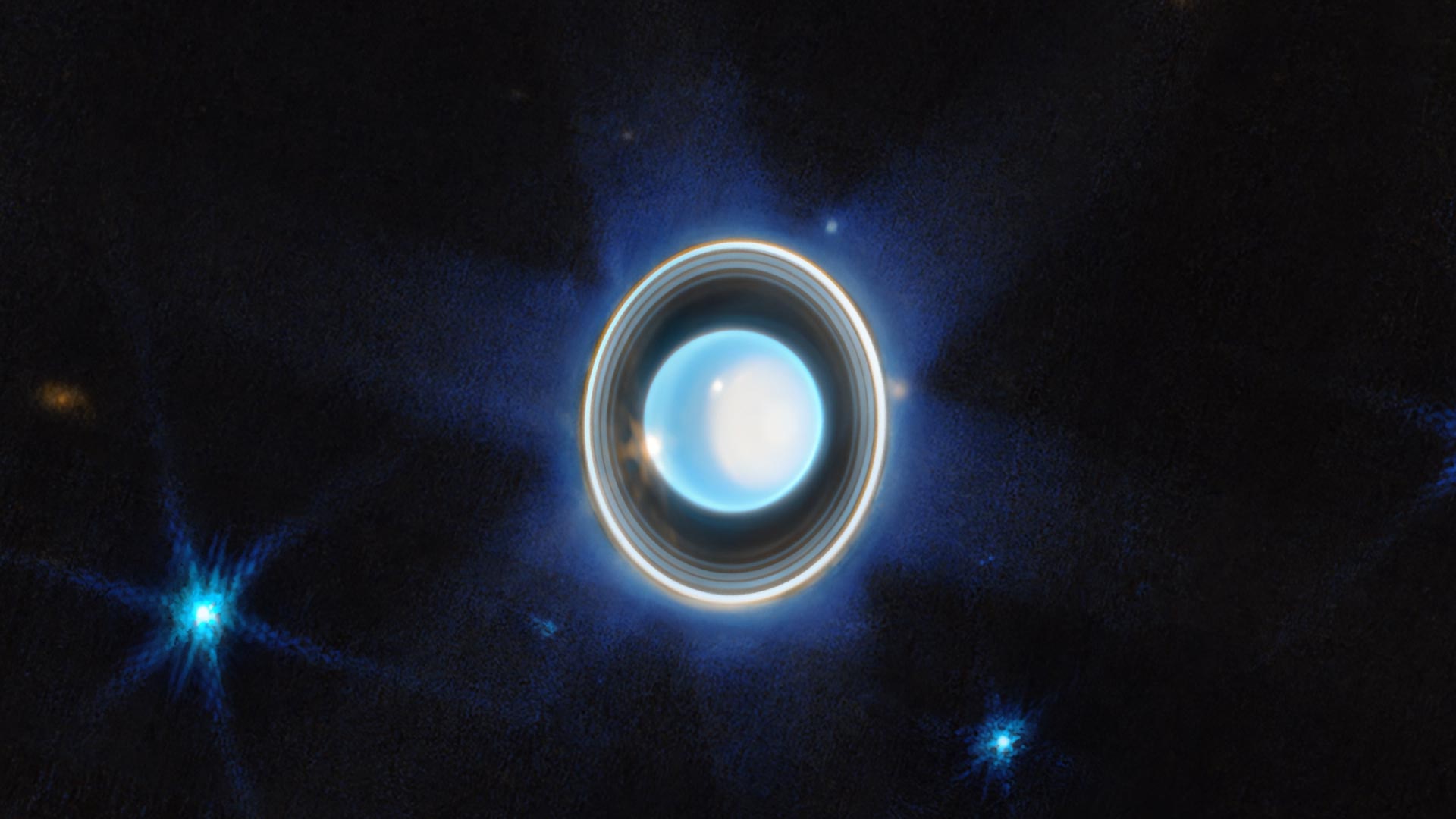Źródło: Nauka: NASA, ESA, CSA, STScI, Przetwarzanie obrazu: Joseph DiPasquale (STScI)
Zdjęcie Webba w podczerwieni uwydatnia dramatyczne pierścienie planety i dynamiczną atmosferę
Wszechświat[{” attribute=””>Uranus is an oddball in our solar system, tilted on its side as it orbits the sun, causing extreme seasons. While the planet’s atmosphere appeared nearly featureless when visited by the Voyager 2 spacecraft in 1986, subsequent observations from the ground and in space have shown turbulent storms.
NASA’s James Webb Space Telescope recently observed Uranus, and the resulting image highlights a complex system of rings as well as a bright polar cap and likely storm clouds.

This zoomed-in image of Uranus, captured by Webb’s Near-Infrared Camera (NIRCam) on February 6, 2023, reveals stunning views of the planet’s rings. The planet displays a blue hue in this representative-color image, made by combining data from two filters (F140M, F300M) at 1.4 and 3.0 microns, which are shown here as blue and orange, respectively. Credit: Science: NASA, ESA, CSA, STScI, Image Processing: Joseph DePasquale (STScI)
Webb Space Telescope Scores Another Ringed World with New Image of Uranus
Following in the footsteps of the Neptune image released in 2022, NASA’s James Webb Space Telescope has taken a stunning image of the solar system’s other ice giant, the planet Uranus. The new image features dramatic rings as well as bright features in the planet’s atmosphere. The Webb data demonstrates the observatory’s unprecedented sensitivity for the faintest dusty rings, which have only ever been imaged by two other facilities: the Voyager 2 spacecraft as it flew past the planet in 1986, and the Keck Observatory with advanced adaptive optics.
The seventh planet from the Sun, Uranus is unique: It rotates on its side, at roughly a 90-degree angle from the plane of its orbit. This causes extreme seasons since the planet’s poles experience many years of constant sunlight followed by an equal number of years of complete darkness. (Uranus takes 84 years to orbit the Sun.) Currently, it is late spring for the northern pole, which is visible here; Uranus’ northern summer will be in 2028. In contrast, when Voyager 2 visited Uranus it was summer at the south pole. The south pole is now on the ‘dark side’ of the planet, out of view and facing the darkness of space.

This zoomed-in image of Uranus, captured by Webb’s Near-Infrared Camera (NIRCam) on February 6, 2023, reveals stunning views of the planet’s rings. On the right side of the planet, there’s an area of brightening at the pole facing the Sun, known as a polar cap. This polar cap is unique to Uranus because it is the only planet in the solar system tilted on its side, which causes its extreme seasons. A new aspect of the polar cap revealed by Webb is a subtle brightening near the Uranian north pole. At the edge of the polar cap lies a bright cloud as well as a few fainter extended features just northward of the cap’s edge, and a second very bright cloud is seen at the planet’s left limb. Such clouds are typical for Uranus in infrared wavelengths, and likely are connected to storm activity. Credit: Science: NASA, ESA, CSA, STScI, Image Processing: Joseph DePasquale (STScI)
This infrared image from Webb’s Near-Infrared Camera (NIRCam) combines data from two filters at 1.4 and 3.0 microns, which are shown here in blue and orange, respectively. The planet displays a blue hue in the resulting representative-color image.
When Voyager 2 looked at Uranus, its camera showed an almost featureless blue-green ball in visible wavelengths. With the infrared wavelengths and extra sensitivity of Webb we see more detail, showing how dynamic the atmosphere of Uranus really is.

This wider view of the Uranian system with Webb’s NIRCam instrument features the planet Uranus as well as six of its 27 known moons (most of which are too small and faint to be seen in this short exposure). A handful of background objects, including many galaxies, are also seen. Credit: Science: NASA, ESA, CSA, STScI, Image Processing: Joseph DePasquale (STScI)
On the right side of the planet, there’s an area of brightening at the pole facing the Sun, known as a polar cap. This polar cap is unique to Uranus – it seems to appear when the pole enters direct sunlight in the summer and vanish in the fall; these Webb data will help scientists understand the currently mysterious mechanism. Webb revealed a surprising aspect of the polar cap: a subtle enhanced brightening at the center of the cap. The sensitivity and longer wavelengths of Webb’s NIRCam may be why we can see this enhanced Uranus polar feature when it has not been seen as clearly with other powerful telescopes like the Hubble Space Telescope and Keck Observatory.
At the edge of the polar cap lies a bright cloud as well as a few fainter extended features just beyond the cap’s edge, and a second very bright cloud is seen at the planet’s left limb. Such clouds are typical for Uranus in infrared wavelengths, and likely are connected to storm activity.
This planet is characterized as an ice giant due to the chemical make-up of its interior. Most of its mass is thought to be a hot, dense fluid of “icy” materials – water, methane, and ammonia – above a small rocky core.
Kosmiczny Teleskop Jamesa Webba wykonał oszałamiające zdjęcie innej lodowej gigantycznej planety Układu Słonecznego, Urana. Nowe zdjęcie przedstawia ekscytujące pierścienie, a także jasne obiekty w atmosferze planety. Nowe dane Webba dotyczące Urana zapewniają niezwykłą czułość, ujawniając najsłabsze z pierścieni pyłowych. Siódma planeta od Słońca, Uran, jest dziwna: obraca się na boku pod kątem około 90 stopni od płaszczyzny swojej orbity. Powoduje to niezwykłe pory roku, ponieważ bieguny planety doświadczają 42 lat ciągłego światła słonecznego i 42 lat całkowitej ciemności (Uran potrzebuje 84 lat na okrążenie Słońca). Obecnie jest późna wiosna na biegunie północnym, który znajduje się po prawej stronie tego zdjęcia; Północne lato będzie na Uranie w 2028 roku.
Uran ma 13 znanych pierścieni, a 11 z nich jest widocznych na tym obrazie internetowym. Niektóre z tych pierścieni są tak jasne w przypadku Webba, że kiedy są blisko siebie, wydają się łączyć w większy pierścień. Dziewięć sklasyfikowano jako główne pierścienie planety, a dwa to słabe pierścienie pyłowe (takie jak rozproszony pierścień Zety najbliżej planety), które zostały odkryte dopiero podczas przelotu sondy Voyager 2 w 1986 roku. Naukowcy spodziewają się, że przyszłe zdjęcia Urana wykonane przez Webba ujawni dwa słabe zewnętrzne pierścienie, które były Dowiedz się z Hubble’a Podczas przelotu samolotu okrężnego w 2007 roku.
Webb sfotografował również wiele z 27 znanych księżyców Urana (większość z nich jest zbyt mała i słaba, aby je tu zobaczyć); Sześć najjaśniejszych jest zidentyfikowanych na szerokokątnym obrazie. To było tylko krótkie 12-minutowe zdjęcie Urana z tylko dwoma kandydatami. To tylko wierzchołek góry lodowej tego, co Webb może zrobić, obserwując tę tajemniczą planetę. Obecnie trwają dodatkowe badania Urana, a kolejne planowane są w pierwszym roku działalności naukowej Webba.
W 2022 roku Narodowe Akademie Nauk, Inżynierii i Medycyny wyznaczyły naukę o Uranie jako priorytet w naukach planetarnych i astrobiologii 2023-2033 Skanowanie mojego węzła.
Kosmiczny Teleskop Jamesa Webba jest czołowym na świecie kosmicznym obserwatorium naukowym. Odsłoni tajemnice naszego Układu Słonecznego, zbada odległe planety krążące wokół innych gwiazd, zbada tajemnicze struktury i początki wszechświata oraz nasze miejsce w nim. Program jest wynikiem współpracy między NASA, Europejską Agencją Kosmiczną (ESA) i Kanadyjską Agencją Kosmiczną i jest prowadzony przez NASA.

„Odkrywca. Nieprzepraszający przedsiębiorca. Fanatyk alkoholu. Certyfikowany pisarz. Wannabe tv ewangelista. Fanatyk Twittera. Student. Badacz sieci. Miłośnik podróży.”






More Stories
Nowe badania pokazują, że dinozaury nie były tak inteligentne, jak sądziliśmy
Naukowcy przygotowują się na burze słoneczne na Marsie
W końcu otwarto najwyższe obserwatorium na Ziemi, położone wysoko w Andach w Chile